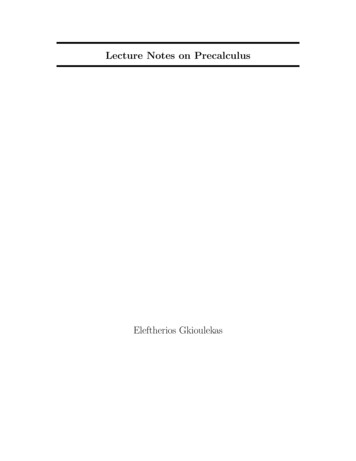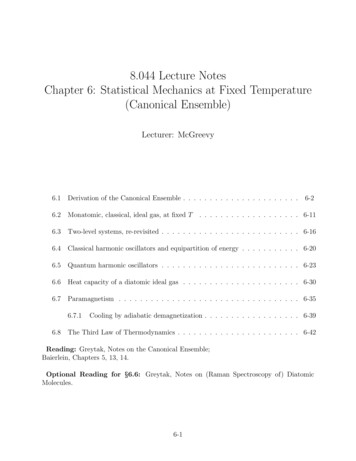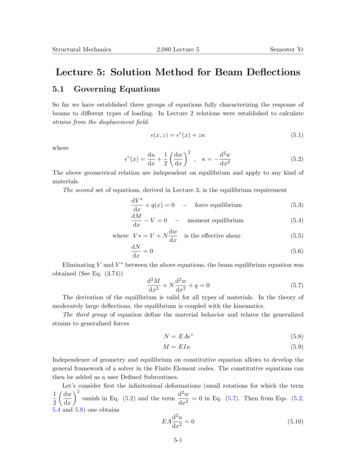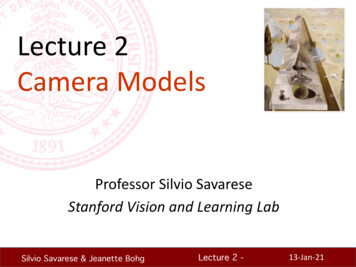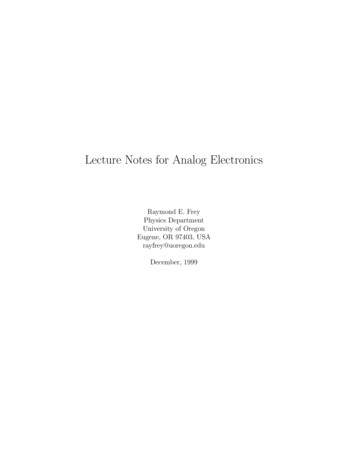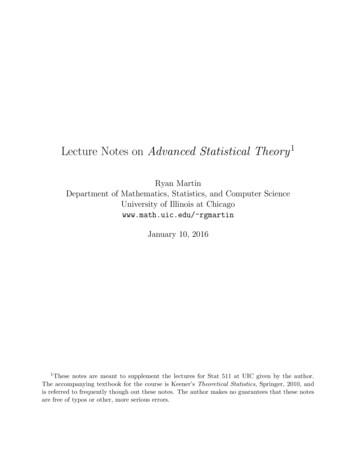
Transcription
Lecture Notes on Advanced Statistical Theory 1Ryan MartinDepartment of Mathematics, Statistics, and Computer ScienceUniversity of Illinois at Chicagowww.math.uic.edu/ rgmartinJanuary 10, 20161 Thesenotes are meant to supplement the lectures for Stat 511 at UIC given by the author.The accompanying textbook for the course is Keener’s Theoretical Statistics, Springer, 2010, andis referred to frequently though out these notes. The author makes no guarantees that these notesare free of typos or other, more serious errors.
Contents1 Introduction and Preparations1.1 Introduction . . . . . . . . . . . . . . . . . . . . . .1.2 Mathematical preliminaries . . . . . . . . . . . . .1.2.1 Measure and integration . . . . . . . . . . .1.2.2 Basic group theory . . . . . . . . . . . . . .1.2.3 Convex sets and functions . . . . . . . . . .1.3 Probability . . . . . . . . . . . . . . . . . . . . . .1.3.1 Measure-theoretic formulation . . . . . . . .1.3.2 Conditional distributions . . . . . . . . . . .1.3.3 Jensen’s inequality . . . . . . . . . . . . . .1.3.4 A concentration inequality . . . . . . . . . .1.3.5 The “fundamental theorem of statistics” . .1.3.6 Parametric families of distributions . . . . .1.4 Conceptual preliminaries . . . . . . . . . . . . . . .1.4.1 Ingredients of a statistical inference problem1.4.2 Reasoning from sample to population . . . .1.5 Exercises . . . . . . . . . . . . . . . . . . . . . . . .2 Exponential Families, Sufficiency, and Information2.1 Introduction . . . . . . . . . . . . . . . . . . . . . . .2.2 Exponential families of distributions . . . . . . . . . .2.3 Sufficient statistics . . . . . . . . . . . . . . . . . . .2.3.1 Definition and the factorization theorem . . .2.3.2 Minimal sufficient statistics . . . . . . . . . .2.3.3 Ancillary and complete statistics . . . . . . .2.4 Fisher information . . . . . . . . . . . . . . . . . . .2.4.1 Definition . . . . . . . . . . . . . . . . . . . .2.4.2 Sufficiency and information . . . . . . . . . .2.4.3 Cramer–Rao inequality . . . . . . . . . . . . .2.4.4 Other measures of information . . . . . . . . .2.5 Conditioning . . . . . . . . . . . . . . . . . . . . . .2.6 Discussion . . . . . . . . . . . . . . . . . . . . . . . .2.6.1 Generalized linear models . . . . . . . . . . 40414243444646
2.72.6.2 A bit more about conditioning . . . . . . . . . . . . . . . . . . . . . .Exercises . . . . . . . . . . . . . . . . . . . . . . . . . . . . . . . . . . . . . .3 Likelihood and Likelihood-based Methods3.1 Introduction . . . . . . . . . . . . . . . . . . . .3.2 Likelihood function . . . . . . . . . . . . . . . .3.3 Likelihood-based methods and first-order theory3.3.1 Maximum likelihood estimation . . . . .3.3.2 Likelihood ratio tests . . . . . . . . . . .3.4 Cautions concerning the first-order theory . . .3.5 Alternatives to the first-order theory . . . . . .3.5.1 Bootstrap . . . . . . . . . . . . . . . . .3.5.2 Monte Carlo and plausibility functions .3.6 On advanced likelihood theory . . . . . . . . . .3.6.1 Overview . . . . . . . . . . . . . . . . .3.6.2 “Modified” likelihood . . . . . . . . . . .3.6.3 Asymptotic expansions . . . . . . . . . .3.7 A bit about computation . . . . . . . . . . . . .3.7.1 Optimization . . . . . . . . . . . . . . .3.7.2 Monte Carlo integration . . . . . . . . .3.8 Discussion . . . . . . . . . . . . . . . . . . . . .3.9 Exercises . . . . . . . . . . . . . . . . . . . . . .4 Bayesian Inference4.1 Introduction . . . . . . . . . . . . . . . . . . . . . .4.2 Bayesian analysis . . . . . . . . . . . . . . . . . . .4.2.1 Basic setup of a Bayesian inference problem4.2.2 Bayes’s theorem . . . . . . . . . . . . . . . .4.2.3 Inference . . . . . . . . . . . . . . . . . . . .4.2.4 Marginalization . . . . . . . . . . . . . . . .4.3 Some examples . . . . . . . . . . . . . . . . . . . .4.4 Motivations for the Bayesian approach . . . . . . .4.4.1 Some miscellaneous motivations . . . . . . .4.4.2 Exchangeability and deFinetti’s theorem . .4.5 Choice of priors . . . . . . . . . . . . . . . . . . . .4.5.1 Prior elicitation . . . . . . . . . . . . . . . .4.5.2 Convenient priors . . . . . . . . . . . . . . .4.5.3 Many candidate priors and robust Bayes . .4.5.4 Objective or non-informative priors . . . . .4.6 Bayesian large-sample theory . . . . . . . . . . . .4.6.1 Setup . . . . . . . . . . . . . . . . . . . . .4.6.2 Laplace approximation . . . . . . . . . . . .4.6.3 Bernstein–von Mises theorem . . . . . . . 4767676787980838384878787878889899091
4.74.8Concluding remarks . . . . . . . . . . . . . . . . . . . .4.7.1 Lots more details on Bayesian inference . . . . .4.7.2 On Bayes and the likelihood principle . . . . . .4.7.3 On the “Bayesian” label . . . . . . . . . . . . .4.7.4 On “objectivity” . . . . . . . . . . . . . . . . .4.7.5 On the role of probability in statistical inferenceExercises . . . . . . . . . . . . . . . . . . . . . . . . . .5 Statistical Decision Theory5.1 Introduction . . . . . . . . . . . . . . . . .5.2 Admissibility . . . . . . . . . . . . . . . .5.3 Minimizing a “global” measure of risk . . .5.3.1 Minimizing average risk . . . . . .5.3.2 Minimizing maximum risk . . . . .5.4 Minimizing risk under constraints . . . . .5.4.1 Unbiasedness constraints . . . . . .5.4.2 Equivariance constraints . . . . . .5.4.3 Type I error constraints . . . . . .5.5 Complete class theorems . . . . . . . . . .5.6 On minimax estimation of a normal mean5.7 Exercises . . . . . . . . . . . . . . . . . . 161186 More Asymptotic Theory (incomplete!)6.1 Introduction . . . . . . . . . . . . . . . . . . .6.2 M- and Z-estimators . . . . . . . . . . . . . .6.2.1 Definition and examples . . . . . . . .6.2.2 Consistency . . . . . . . . . . . . . . .6.2.3 Rates of convergence . . . . . . . . . .6.2.4 Asymptotic normality . . . . . . . . .6.3 More on asymptotic normality and optimality6.3.1 Introduction . . . . . . . . . . . . . . .6.3.2 Hodges’s provocative example . . . . .6.3.3 Differentiability in quadratic mean . .6.3.4 Contiguity . . . . . . . . . . . . . . . .6.3.5 Local asymptotic normality . . . . . .6.3.6 On asymptotic optimality . . . . . . .6.4 More Bayesian asymptotics . . . . . . . . . .6.4.1 Consistency . . . . . . . . . . . . . . .6.4.2 Convergence rates . . . . . . . . . . . .6.4.3 Bernstein–von Mises theorem, revisited6.5 Concluding remarks . . . . . . . . . . . . . . .6.6 Exercises . . . . . . . . . . . . . . . . . . . . 371391391393.
Chapter 1Introduction and Preparations1.1IntroductionStat 511 is a first course in advanced statistical theory. This first set of notes is intended toset the stage for the material that is the core of the course. In particular, these notes definethe notation we shall use throughout, and also set the conceptual and mathematical levelwe will be working at. Naturally, both the conceptual and mathematical level will be higherthan in an intermediate course, such as Stat 411 at UIC.On the mathematical side, real analysis and, in particular, measure theory, is very important in probability and statistics. Indeed, measure theory is the foundation on whichmodern probability is built and, by the close connection between probability and statistics,it is natural that measure theory also permeates the statistics literature. Measure theoryitself can be very abstract and difficult. I am not an expert in measure theory, and I don’texpect you to be an expert either. But, in general, to read and understand research papersin statistical theory, one should at least be familiar with the basic terminology and resultsof measure theory. My presentation here is meant to introduce you to these basics, so thatwe have a working measure-theoretic vocabulary moving forward to our main focus in thecourse. Keener (2010), the course textbook, also takes a similar approach to its measuretheory presentation. Besides measure theory, I will also give some brief introduction togroup theory and convex sets/functions. The remainder of this first set of notes concernsthe transitions from measure theory to probability and from probability to statistics.On the conceptual side, besides being able to apply theory to particular examples, I hopeto communicate why such theory was developed; that is, not only do I want you be familiarwith results and techniques, but I hope you can understand the motivation behind thesedevelopments. Along these lines, in this chapter, I will discuss the basic ingredients of a statistical inference problem, along with some discussion about statistical reasoning, addressingthe fundamental question: how to reason from sample to population? Surprisingly, there’sno fully satisfactory answer to this question.4
1.21.2.1Mathematical preliminariesMeasure and integrationMeasure theory is the foundation on which modern probability theory is built. All statisticians should, at least, be familiar with the terminology and the key results (e.g., Lebesgue’sdominated convergence theorem). The presentation below is based on material in Lehmannand Casella (1998); similar things are presented in Keener (2010).A measure is a generalization of the concept of length, area, volume, etc. More specifically, a measure µ is a non-negative set-function, i.e., µ assigns a non-negative number tosubsets A of an abstract set X, and this number is denoted by µ(A). Similar to lengths, µis assumed to be additive:µ(A B) µ(A) µ(B),for each disjoint A and B.This extends by induction to any finite set A1 , . . . , An of disjoint sets. But a strongerassumption is σ-additivity:µ [ Ai i 1 Xµ(Ai ),for all disjoint A1 , A2 , . . .i 1Note that finite additivity does not imply σ-additivity. All of the (probability) measureswe’re familiar with are σ-additive. But there are some peculiar measures which are finitelyadditive but not σ-additive. The classical example of this is the following.Example 1.1. Take X {1, 2, . . .} and define a measure µ as(0 if A is finiteµ(A) 1 if A is co-finite,where a set A is “co-finite” if it’s the complement of a finite set.S It is easy to see that µis additive. Takinga disjoint sequence Ai {i} we find that µ( i 1 Ai ) µ(X) 1 butPP i 1 0 0. Therefore, µ is not σ-additive.i 1 µ(Ai ) In general, a measure µ cannot be defined for all subsets A X. But the class of subsetson which the measure can be defined is, in general, a σ-algebra, or σ-field.Definition 1.1. A σ-algebra A is a collection of subsets of X such that: X is in A; If A A, then Ac A; and if A1 , A2 , . . . A, thenS i 1Ai A.The sets A A are said to be measurable. We refer to (X, A) as a measurable space and, ifµ is a measure defined on (X, A), then (X, A, µ) is a measure space.5
A measure µ is finite if µ(X) is a finite number. Probability measures (see Section 1.3.1)are special finite measures where µ(X) 1. A measure µ is said to be σ-finite if there existsS a sequence of sets {Ai } A such that i 1 Ai X and µ(Ai ) for each i.Example 1.2. Let X be a countable set and A the class of all subsets of X; then clearly Ais a σ-algebra. Define µ according to the ruleµ(A) number of points in A,A A.Then µ is a σ-finite measure which is refered to as counting measure.Example 1.3. Let X be a subset of d-dimensional Euclidean space Rd . Take A to be thesmallest σ-algebra that contains the collection of open rectanglesA {(x1 , . . . , xd ) : ai xi bi , i 1, . . . , d},ai bi .Then A is the Borel σ-algebra on X, which contains all open and closed sets in X; but thereare subsets of X that do not belong to A! Then the (unique) measure µ, defined byµ(A) dY(bi ai ),for rectangles A Ai 1is called Lebesgue measure, and it’s σ-finite.Next we consider integration of a real-valued function f with respect to a measure µ on(X, A). This more general definition of integral satisfies most of the familiar properties fromcalculus, such as linearity, monotonicity, etc. But the calculus integral is defined only for aclass of functions which is generally too small for our applications.The class of functions of interest are those which are measurable. In particular, a realvalued function f is measurable if and only if, for every real number a, the set {x : f (x) a}is in A. If A is a measurable set, then the indicator function IA (x), which equals 1 whenx A and 0 otherwise, is measurable. More generally, a simple functions(x) KXak IAk (x),k 1is measurable provided that A1 , . . . , AK A. Continuous f are also usually measurable.The integral of a non-negative simple function s with respect to µ is defined asZs dµ KXai µ(Ak ).(1.1)k 1Take a non-decreasing sequence of non-negative simple functions {sn } and definef (x) lim sn (x).n 6(1.2)
It can be shown that f defined in (1.2) is measurable. Then the integral of f with respectto µ is defined asZZf dµ limsn dµ,n the limit of the simple function integrals. It turns out that the left-hand side does notdepend on the particular sequence {sn }, so it’s unique. In fact, an equivalent definition forthe integral of a non-negative f isZZf dµ sups dµ.(1.3)0 s f , simpleFor a general measurable function f which may take negative values, definef (x) max{f (x), 0} and f (x) min{f (x), 0}.Both the positive part f and the negative part f are non-negative, and f f f . Theintegral of f with respect to µ is defined asZZZ f dµ f dµ f dµ,where the two integrals on the right-hand side are defined through R(1.3). In general,aRmeasurable function f is said to be µ-integrable, or just integrable, if f dµ and f dµare both finite.Example 1.4 (Counting measure). If X {x1 , x2 , . . .} and µ is counting measure, thenZ Xf dµ f (xi ).i 1Example1.5 (Lebesgue measure). If X is a Euclidean space and µ is Lebesgue measure,Rthen f dµ exists and is equal to the usual Riemann integral of f from calculus wheneverthe latter exists. But the Lebesgue integral exists for f which are not Riemann integrable.Next we list some important results from analysis, related to integrals. The first twohave to do with interchange of limits1 and integration, which is often important in statisticalproblems. The first is relatively weak, but is used in the proof of the second.Theorem 1.1 (Fatou’s lemma). Given {fn }, non-negative and measurable,Z Z lim inf fn dµ lim inf fn dµ.n n The opposite inequality holds for lim sup, provided that fn g for integrable g.1Recall the notions of “lim sup” and “lim inf” from analysis. For example, if xn is a sequence of realnumbers, then lim supn xn inf n supk n xk and, intuitively, this is the largest accumulation point ofthe sequence; similarly, lim inf n xn is the smallest accumulation point, and if the largest and smallestaccumulations points are equal, then the sequence converges and the common accumulation point is thelimit. Also, if fn is a sequence of real-valued functions, then we can define lim sup fn and lim inf fn byapplying the previous definitions pointwise.7
Theorem 1.2 (Dominated convergence). Given measurable {fn }, suppose thatf (x) lim fn (x)n µ-almost everywhere,and fn (x) g(x) for all n, for all x, and for some integrable function g. Then fn and fare integrable, andZZf dµ limfn dµ.n Proof. First, by definition of f as the pointwise limit of fn , we have that fn f fn f 2g and lim supn fn f 0. From Exercise 8, we getZZZZfn dµ f dµ (fn f ) dµ fn f dµand, for the upper bound, by the “reverse Fatou’s lemma,” we haveZZlim sup fn f dµ lim sup fn f dµ 0.nTherefore,Rfn dµ Rnf dµ, which completes the proof.Note, the phrase “µ-almost everywhere” used in the theorem means that the propertyholds everywhere except on a µ-null set, i.e., a set N with µ(N ) 0. These sets of measurezero are sets which are “small” in a measure-theoretic sense, as opposed to meager firstcategory sets which are small is a topological sense. Roughly, sets of measure zero can beignored in integration and certain kinds of limits, but one should always be careful.The next theorem is useful for bounding integrals of products of two functions. Youmay be familiar with this name from other courses, such as linear algebra—it turns outactually, that certain collections of integrable functions act very much the same as vectorsin a finite-dimensional vector space.Theorem 1.3 (Cauchy–Schwarz inequality). If f and g are measurable, thenZ Z 2 Z2f g dµ f dµ · g 2 dµ.Proof. If either f 2 or g 2 is not integrable, thenis trivial; so assume that bothR the inequality222f and g are integrable. Take any λ; then (f λg) dµ 0. In particular,RRR 2g dµ ·λ2 2 f g dµ ·λ g 2 dµ 0 λ. {z } {z } {z }acbIn other words, the quadratic (in λ) can have at most one real root. Using the quadraticformula, b b2 4acλ ,2a8
it is clear that the only way there can be fewer than two real roots is if b2 4ac is 0. Usingthe definitions of a, b, and c we find thatZZ Z 224f g dµ 4 f dµ · g 2 dµ 0,and from this the result follows immediately. A different proof, based on Jensen’s inequality,is given in Example 1.8.The next result defines “double-integrals” and shows that, under certain conditions, theorder of integration does not matter. Fudging a little bit on the details, for two measurespaces (X, A, µ) and (Y, B, ν), define the product space(X Y, A B, µ ν),where X Y is usual set of ordered pairs (x, y), A B is the smallest σ-algebra that containsall the sets A B for A A and B B, and µ ν is the product measure defined as(µ ν)(A B) µ(A)ν(B).This concept is important for us because independent probability distributions induce aproduct measure. Fubini’s theorem is a powerful result that allows certain integrals over theproduct to be done one dimension at a time.Theorem 1.4 (Fubini). Let f (x, y) be a non-negative measurable function on X Y. ThenZ hZZ hZiif (x, y) dµ(x) dν(y).(1.4)f (x, y) dν(y) dµ(x) XYYXThe common value above is the double integral, writtenRX Yf d(µ ν).Our last result has something to do with constructing new measures from old. It alsoallows us to generalize the familiar notion of probability densities which, in turn, will makeour lives easier when discussing the general statistical inference problem. Suppose f is anon-negative2 measurable function. ThenZν(A) f dµ(1.5)Adefines a new measure ν on (X, A). An important property is that µ(A) 0 implies ν(A) 0;the terminology is that ν is absolutely continuous with respect to µ, or ν is dominated by µ,written ν µ. But it turns out that, if ν µ, then there exists f such that (1.5) holds.This is the famous Radon–Nikodym theorem.Theorem 1.5 (Radon–Nikodym). Suppose ν µ. Then there exists a non-negative µintegrable function f , unique modulo µ-null sets, such that (1.5) holds. The function f ,often written as f dν/dµ is the Radon–Nikodym derivative of ν with respect to µ.2f can take negative values, but then the measure is a signed measure.9
We’ll see later that, in statistical problems, the Radon–Nikodym derivative is the familiardensity or, perhaps, a likelihood ratio. The Radon–Nikodym theorem also formalizes the ideaof change-of-variables in integration. For example, suppose that µ and ν are σ-finite measuresdefined on X, such that ν µ, so that there exists a unique Radon–Nikodym derivativef dν/dµ. Then, for a ν-integrable function ϕ, we haveZZϕ dν ϕ f dµ;symbolically this makes sense: dν (dν/dµ) dµ.1.2.2Basic group theoryAn important mathematical object is that of a group, a set of elements together with acertain operation having a particular structure. Our particular interest (Section 1.3.6) isin groups of transformations and how they interact with probability distributions. Here weset some very basic terminology and understanding of groups. A course on abstract algebrawould cover these concepts, and much more.Definition 1.2. A group is a set G together with a binary operation ·, such that: (closure) for each g1 , g2 G , g1 · g2 G ; (identity) there exists e G such that e · g g for all g G ; (inverse) for each g G , there exists g 1 G such that g 1 · g e; (associative) for each g1 , g2 , g3 G , g1 · (g2 · g3 ) (g1 · g2 ) · g3 .The element e is called the identity, and the element g 1 is called the inverse of g. Thegroup G is called abelian, or commutative, if g1 · g2 g2 · g1 for all g1 , g2 G .Some basic examples of groups include (Z, ), (R, ), and (R\{0}, ); the latter requiresthat the origin be removed since 0 has no multiplicative inverse. These three groups areabelian. The general linear group of dimension m, consisting of all m m non-singularmatrices, is a group under matrix multiplication; this is not an abelian group. Some simpleproperties of groups are given in Exercise 10.We are primarily interested in groups of transformations. Let X be a space (e.g., a samplespace) and consider a collection G of functions g, mapping X to itself. Consider the operation of function composition. The identity element e is the function e(x) x for all x X. Ifwe require that (G , ) be a group with identity e, then each g G is a one-to-one function.To see this, take any g G and take x1 , x2 X such that g(x1 ) g(x2 ). Left compositionby g 1 gives e(x1 ) e(x2 ) and, consequently, x1 x2 ; therefore, g is one-to-one. Someexamples of groups of transformations are: For X Rm , define the map gc (x) x c, a shift of the vector x by a vector c. ThenG {gc : c Rm } is an abelian group of transformations.10
For X Rm , define the map gc (x) cx, a rescaling of the vector x by a constant c.Then G {gc : c 0} is an abelian group of transformations. For X Rm , let ga,b (x) ax b1m , a combination of the shift and scaling of x. ThenG {ga,b : a 0, b R} is a group of transformations; not abelian. For X Rm , let gA (x) Ax, where A GL(m). Then G {gA : A GL(m)} is agroup of transformations; not abelian. Let X {1, 2, . . . , m} and define gπ (x) (xπ(1) , . . . , xπ(m) ), where π is a permutationof the indices. Then G {gπ : permutations π} is a group of transformations; notabelian.In the literature on groups of transformations, it is typical to write gx instead of g(x).For a given group of transformations G on X, there are some other classes of functions whichare of interest. A function α, mapping X to itself, is called invariant (with respect to G ) ifα(gx) α(x) for all x X and all g G . A function β, mapping X to itself, is equivariant(with respect to G ) if β(gx) gβ(x) for all x X and all g G . The idea is that α is notsensitive to changes induced by mapping x 7 gx for g G , and β doesn’t care whether g isapplied before or after. Next is a simple but important example.Example 1.6. Let X Rm and define maps gc (x) x c1m , the location shifts. Thefunction β(x) x̄1m is equivariant with respect to G , where x̄ is the average of the entriesof x. The function α(x) x x̄1m is invariant with respect to G .A slightly different notion of invariance with respect to a group of transformations, in acontext relevant to probability and statistics, will be considered in Section 1.3.6.1.2.3Convex sets and functionsThere is a special property that functions can have which will we will occasionally takeadvantage of later on. This property is called convexity. Throughout this section, unlessotherwise stated, take f (x) to be a real-valued function defined over a p-dimensional Euclidean space X. The function f is said to be convex on X if, for any x, y X and anyα [0, 1], the following inequality holds:f (αx (1 α)y) αf (x) (1 α)f (y).For the case p 1, this property is easy to visualize. Examples of convex (univariate)functions include ex , log x, xr for r 1.In the case where f is twice differentiable, there is an alternative characterization ofconvexity. This is something that’s covered in most intermediate calculus courses.Proposition 1.1. A twice-differentiable function f , defined on p-dimensional space, is convex if and only if 2 f (x) 2, f (x) xi xj i,j 1,.,pthe matrix of second derivatives, is positive semi-definite for each x.11
Convexity is important in optimization problems (maximum likelihood, least squares, etc)as it relates to existence and uniqueness of global optima. For example, if the criterion (loss)function to be minimized is convex and a local minimum exists, then convexity guaranteesthat it’s a global minimum.“Convex” can be used as an adjective for sets, not just functions. A set C, in a linearspace, is convex if, for any points x and y in C, the convex combination ax (1 a)y,for a [0, 1], is also a point in C. In other words, a convex set C contains line segmentsconnecting all pairs of points in C. Examples of convex sets are interval of numbers, circlesin the plane, and balls/ellipses in higher dimensions. There is a connection between convexsets and convex functions: if f is a convex real-valued function, then, for any real t, the setCt {x : f (x) t} is convex (see Exercise 15). There will be some applications of convexsets in the later chapters.31.31.3.1ProbabilityMeasure-theoretic formulationIt turns out the mathematical probability is just a special case of the measure theory stuffpresented above. Our probabilities are finite measures, our random variables are measurablefunctions, our expected values are integrals.Start with an essentially arbitrary measurable space (Ω, F), and introduce a probabilitymeasure P; that is P(Ω) 1. Then (Ω, F, P) is called a probability space. The idea is that Ωcontains all possible outcomes of the random experiment. Consider, for example, the heightsexample above in Section 1.4.1. Suppose we plan to sample a single UIC student at randomfrom the population of students. Then Ω consists of all students, and exactly one of thesestudents will be the one that’s observed. The measure P will encode the underlying samplingscheme. But in this example, it’s not the particular student chosen that’s of interest: wewant to know the student’s height, which is a measurement or characteristic of the sampledstudent. How do we account for this?A random variable X is nothing but a measurable function from Ω to another space X.It’s important to understand that X, as a mapping, is not random; instead, X is a functionof a randomly chosen element ω in Ω. So when we are discussing probabilities that X satisfiessuch and such properties, we’re actually thinking about the probability (or measure) the setof ω’s for which X(ω) satisfies the particular property. To make this more precise we writeP(X A) P{ω : X(ω) A} PX 1 (A).To simplify notation, etc, we will often ignore the underlying probability space, and worksimply with the probability measure PX (·) PX 1 (·). This is what we’re familiar with frombasic probability and statistics; the statement X N(0, 1) means simply that the probability3e.g., the parameter space for natural exponential families is convex; Anderson’s lemma, which is used toprove minimaxity in normal mean problems, among other things, involves convex sets; etc.12
measure induced on R by the mapping X is a standard normal distribution. When there isno possibility of confusion, we will drop the “X” subscript and simply write P for PX .When PX , a measure on the X-space X, is dominated by a σ-finite measure µ, theRadon–Nikodym theorem says there is a density dPX /dµ pX , andZpX dµ.PX (A) AThis is the familiar case we’re used to; when µ is counting measure, pX is a probability massfunction and, when µ is Lebesgue measure, pX is a probability density function. One of thebenefits of the measure-theoretic formulation is that we do not have to handle these twoimportant cases separately.Let ϕ be a real-valued measurable function defined on X. Then the expected value ofϕ(X) isZZEX {ϕ(X)} ϕ(x) dPX (x) Xϕ(x)pX (x) dµ(x),Xthe latter expression holding only when PX µ for a σ-finite measure µ on X. The usualproperties of expected value (e.g., linearity) hold in this more general case; the same toolswe use in measure theory to study properties of integrals of measurable functions are usefulfor deriving such things.In these notes, it will be assumed you are familiar with all the bas
Stat 511 is a rst course in advanced statistical theory. This rst set of notes is intended to set the stage for the material that is the core of the course. In particular, these notes de ne the notation w




